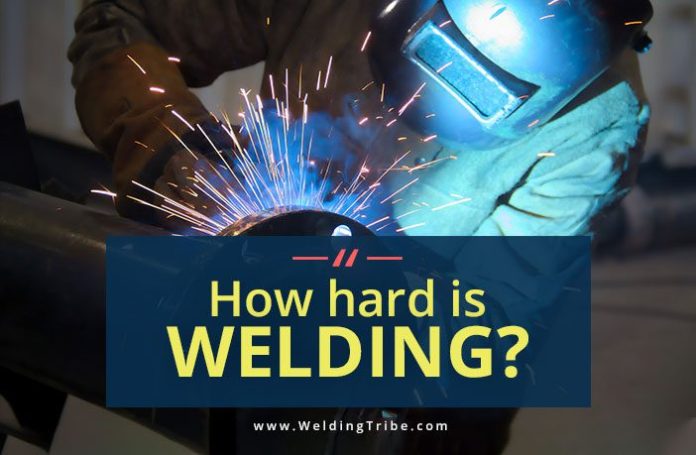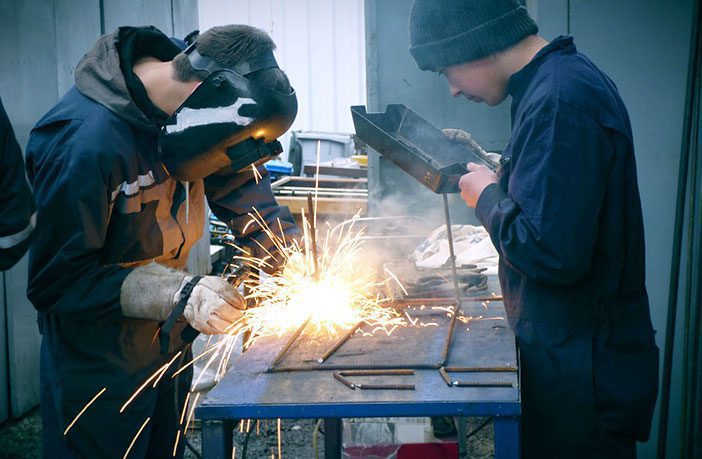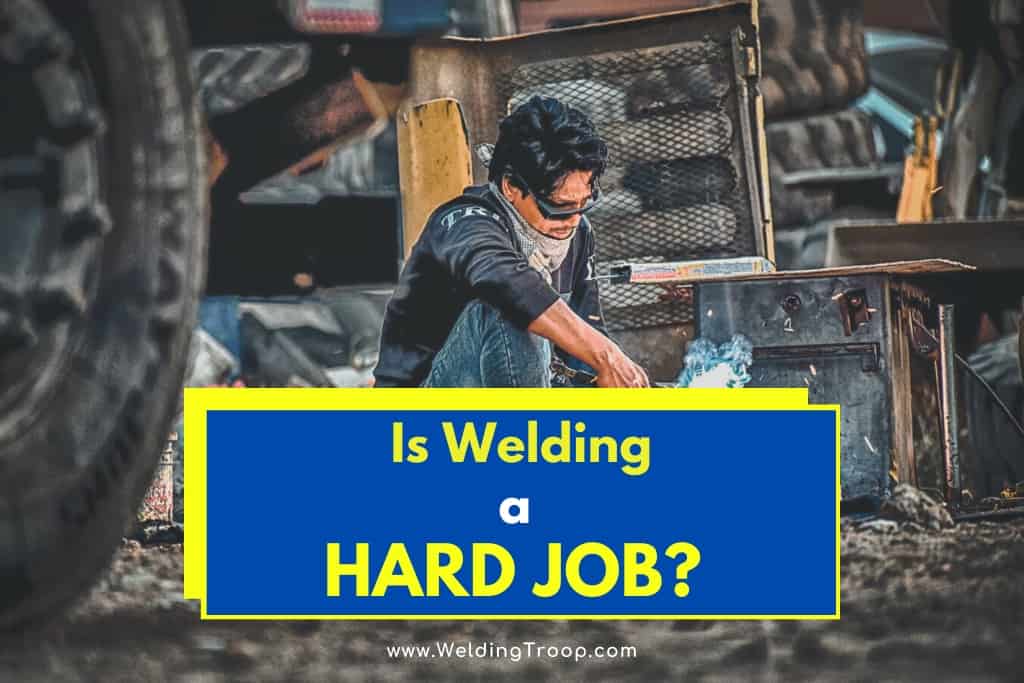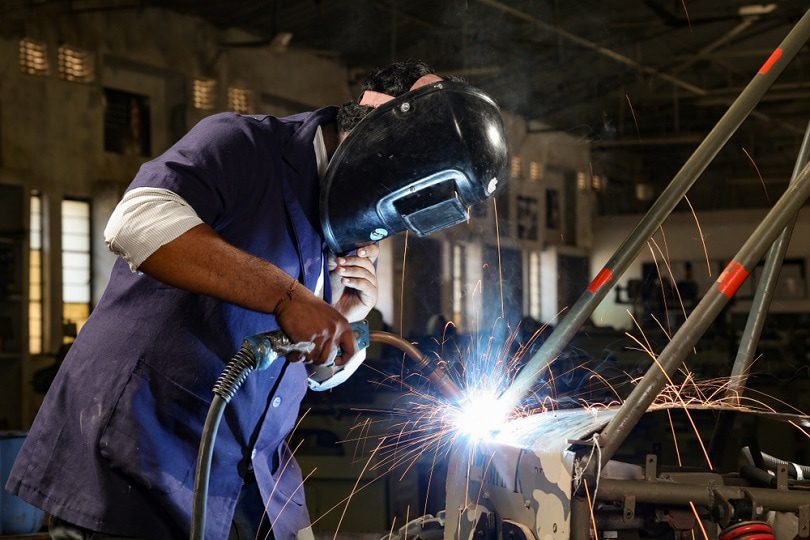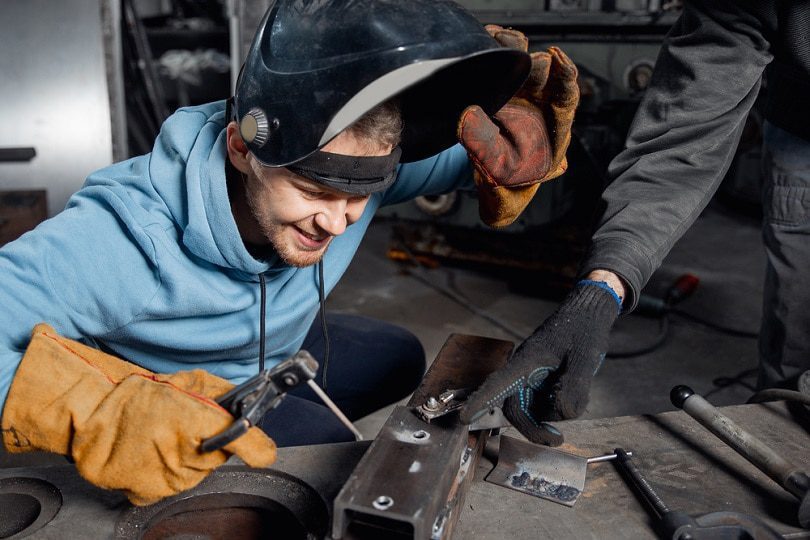Are you considering a career in welding but wondering if it’s a difficult path to pursue? Well, let me ease your concerns and assure you that despite its technical nature, welding is not as hard to get into as you might think. With the right training, dedication, and a passion for the craft, you can embark on a fulfilling and lucrative career in welding. So, if you’re ready to explore a hands-on profession that combines skill, creativity, and precision, let’s dive into the world of welding and discover the countless opportunities that await you.
What is Welding?
Welding is a process that involves joining two or more materials, typically metals, by heating them to a melting point and allowing them to cool and fuse together. It is an essential technique used in various industries to create strong and durable joints between metal components. Whether it’s constructing buildings, manufacturing automobiles, or repairing infrastructure, welding plays a crucial role in ensuring structural integrity and functional efficiency.
Definition of welding
Welding is the process of using heat and pressure to fuse two or more materials together, typically metals, creating a permanent joint that is as strong as, if not stronger than, the original materials. This is achieved by melting the materials at the joint using a heat source, such as an electric arc or a flame, and applying pressure to ensure proper bonding. The molten material then cools and solidifies, forming a solid connection between the joined pieces.
Types of welding
There are several different methods of welding, each tailored to specific applications and materials. The choice of welding technique depends on factors such as the type and thickness of the materials being joined, the desired strength of the weld, and the available equipment and resources. Some common types of welding include:
- Arc Welding: This is a popular and widely used welding technique that utilizes an electric arc to create heat and melt the materials being joined. Various subtypes of arc welding include Shielded Metal Arc Welding (SMAW), Gas Metal Arc Welding (GMAW), and Flux-Cored Arc Welding (FCAW).
- Gas Welding: This method involves using a flame produced by burning a mixture of fuel gas and oxygen to generate the heat required for welding. Gas welding is often used for joining thin materials and is commonly utilized in the automotive industry.
- Tungsten Inert Gas (TIG) Welding: TIG welding, also known as Gas Tungsten Arc Welding (GTAW), uses a non-consumable tungsten electrode to produce the arc and a separate filler material to create the weld. This technique is especially suitable for welding thin sections of stainless steel and aluminum.
- Metal Inert Gas (MIG) Welding: MIG welding, or Gas Metal Arc Welding (GMAW), uses a consumable electrode and a shielding gas to protect the weld from contamination. It is known for its versatility and is commonly employed in the fabrication of automotive parts and structural steel.
- Resistance Welding: This method involves passing an electric current through the materials to be joined, creating heat at the contact points and causing them to fuse together. Resistance welding is widely used in the automotive industry for spot welding and projection welding.
These are just a few examples of the many welding techniques available, each offering advantages and limitations depending on the specific requirements of the project.
Importance of welding in various industries
Welding is an essential process that serves as the backbone of numerous industries. Without welding, many of the structures and products we rely on daily would not exist. Here are some industries where welding is of utmost importance:
- Construction: Welding is vital in the construction industry for joining structural steel and reinforcing bars, creating the framework of buildings, bridges, and other infrastructure.
- Automotive: Welding is extensively used in the manufacturing of automobiles, ensuring the integrity and durability of the vehicle’s structure. It is a key process in assembly lines and body repair shops.
- Aerospace: In the aerospace industry, welding is critical for the fabrication of aircraft frames, components, and engine parts. The welding of lightweight materials with high strength requirements, such as aluminum and titanium, demands specialized techniques and expertise.
- Energy and Power Generation: The construction and maintenance of power plants, pipelines, and oil refineries heavily rely on welding. Specialized welding techniques are used to ensure the integrity and safety of critical systems.
- Shipbuilding: Welding plays a crucial role in shipbuilding, enabling the construction of large, seaworthy vessels. It is used to join different sections of the ship, including the hull, superstructure, and piping systems.
- Manufacturing: Welding is an integral part of manufacturing processes, allowing the assembly of various metal products and components, such as machinery, appliances, and furniture.
These examples highlight how welding is essential for building and maintaining the infrastructures, technologies, and products that fuel our modern world. The versatility and strength offered by welding make it an invaluable skill in a wide range of industries.
Skills Required for Welding
To excel in the field of welding, there are certain skills that you need to master. Apart from the physical abilities to handle the nature of the job, technical skills and knowledge of materials and equipment are crucial for ensuring precision and safety.
Physical abilities
Welding is physically demanding work that requires manual dexterity, hand-eye coordination, and good visual acuity. You will need the ability to handle tools and equipment with precision, as well as the stamina to work in various positions for extended periods. Additionally, good physical fitness is essential as welding often involves lifting heavy materials, working in confined spaces, and standing or crouching for long hours.
Technical skills
A solid understanding of welding techniques, equipment operation, and welding codes and standards is essential for any aspiring welder. You should be proficient in using different welding machines and tools, as well as skilled in creating quality welds with proper penetration, strength, and appearance. Knowledge of various welding processes, their advantages, and limitations will empower you to select the most appropriate technique for each job.
Knowledge of materials and equipment
Welding involves working with a wide range of materials, including different types of metals and alloys. Understanding the properties of these materials is crucial for selecting the appropriate welding techniques, filler metals, and parameters to achieve desired results. Furthermore, being knowledgeable about welding equipment, such as power sources, electrodes, and shielding gases, will enable you to optimize the welding process and troubleshoot any issues that may arise.
Expanding your knowledge beyond welding itself to include metallurgy, blueprint reading, and quality assurance will provide you with a comprehensive understanding of the field and enhance your overall performance as a welder.
Education and Training
While a formal education is not always a requirement to enter the field of welding, obtaining a high school education and pursuing additional training can significantly enhance your career prospects and earning potential.
High school education
Completing high school or obtaining a General Education Development (GED) diploma is essential for acquiring basic skills in math, science, and communication. These foundational skills will be valuable throughout your career as a welder, especially when it comes to interpreting blueprints, calculating measurements, and understanding welding procedures and safety protocols.
Vocational training programs
Vocational training programs offer specialized training in welding, equipping you with the practical skills necessary to excel in the field. These programs typically provide hands-on instruction in various welding techniques, using a wide range of materials and equipment. They also cover topics like metallurgy, blueprint reading, welding inspection, and safety procedures.
Vocational training programs can be found at community colleges, trade schools, and technical institutes. They can range in duration from a few months to several years, depending on the level of expertise and certification desired. These programs often include both classroom instruction and extensive hands-on practice, allowing you to develop your skills under the guidance of experienced instructors.
Apprenticeships
Apprenticeships are another valuable pathway to acquire practical welding skills while earning a wage. Apprenticeships typically combine on-the-job training with classroom instruction, allowing you to learn from experienced professionals in a real-world setting. These programs often last several years and culminate in a recognized certification or journeyman status.
Apprenticeships can be obtained through industry associations, trade unions, or directly with employers. They offer a structured approach to learning, providing a balanced combination of theoretical knowledge and hands-on experience. By working alongside experienced welders, apprentices gain practical skills and industry insights that are invaluable for long-term career growth.
Regardless of the education and training path you choose, ongoing professional development is essential in the ever-evolving field of welding. Continuously upgrading your skills through workshops, seminars, and certifications will open up new opportunities and keep you at the forefront of the industry.
Certifications and Licenses
Certifications and licenses are important credentials that demonstrate your expertise and competence in specific areas of welding. They not only validate your skills but also enhance your employability and earning potential.
Certified Welder (CW)
The Certified Welder (CW) certification offered by the American Welding Society (AWS) is a widely recognized credential in the welding industry. It is designed for welders who can demonstrate their ability to produce quality welds based on established standards and procedures. The CW certification involves practical welding tests conducted by AWS-certified welding inspectors to assess your skills in various welding techniques and positions.
Certified Welding Inspector (CWI)
The Certified Welding Inspector (CWI) certification is aimed at professionals who inspect and evaluate welding work to ensure compliance with industry standards and codes. This certification is highly regarded and qualifies you to perform visual inspections, interpret welding procedures, and evaluate the quality of welds. The CWI certification is offered by AWS and requires a combination of education, work experience, and passing an extensive examination.
Specialized welding certifications
There are numerous specialized certifications available for specific welding techniques, materials, and industries. These certifications demonstrate your proficiency in niche areas and can make you highly sought after in specialized fields. Some examples of specialized welding certifications include:
- Certified Welding Educator (CWE): This certification is targeted at welding instructors and educators, validating their knowledge and skills in teaching welding techniques.
- Certified Welding Supervisor (CWS): The CWS certification recognizes professionals who oversee welding operations, ensuring compliance with specifications and standards.
- Certified Robotic Arc Welding (CRAW): This certification is for welders proficient in operating and programming robotic welding systems.
- Certified Welding Sales Representative (CWSR): The CWSR certification is tailored for sales professionals with a comprehensive understanding of welding processes and applications.
These certifications, among others, can offer a competitive edge in the job market and demonstrate your commitment to professional growth and quality craftsmanship.
Job Outlook and Opportunities
The demand for skilled welders continues to remain strong due to the essential role welding plays in various industries. Skilled welders are highly sought after, and job opportunities are diverse and abundant.
Demand for skilled welders
As infrastructure continues to age and new construction and manufacturing projects arise, the need for skilled welders remains steady. Many existing welders are reaching retirement age, creating additional employment opportunities for new entrants to the field. Furthermore, advancements in technology and manufacturing processes often require specialized welding skills, contributing to the demand for welders with niche expertise.
Industries such as construction, manufacturing, automotive, oil and gas, and aerospace are expected to see sustained growth, generating a steady demand for skilled welders. Additionally, as countries invest in infrastructure development and sustainable energy projects, the need for welders will continue to rise.
Career advancement opportunities
Welding offers numerous career advancement opportunities for motivated individuals. With experience and continued education, you can progress in your career and take on more specialized roles or assume supervisory and management positions. Advancement opportunities may include becoming an welding inspector, welding supervisor, welding engineer, or welding educator. You can also choose to specialize in a specific welding process, such as underwater welding, robotic welding, or aerospace welding, which often come with higher pay and increased job security.
Salary potential
The salary potential for welders varies depending on factors such as experience, education, certification, and industry. Generally, skilled welders with relevant certifications and expertise command higher salaries. According to the U.S. Bureau of Labor Statistics, the median annual wage for welders, cutters, solderers, and brazers was $42,490 in May 2020. However, top earners in the field can make upwards of $65,000 per year. Keep in mind that location, industry demand, and job specialization can significantly influence earning potential.
Working Conditions
While welding offers a rewarding career, it is essential to consider the working conditions associated with the profession.
Physical demands of welding
Welding requires prolonged periods of standing, crouching, or kneeling, often in uncomfortable positions. The work may also involve lifting and moving heavy materials, necessitating good physical fitness and stamina. Long hours of precise work can be physically demanding, so maintaining strong overall health and fitness is crucial.
Hazards and safety precautions
Welding involves working with high temperatures, intense light, and potentially hazardous materials. Hazards include the risk of burns, eye injuries from ultraviolet (UV) radiation, inhalation of welding fumes and gases, electrical shocks, and noise exposure. Welders need to take appropriate safety precautions, such as wearing protective gear and clothing, using proper ventilation systems, and following established safety protocols to minimize these risks.
Work environments
Welding can take place in a variety of work environments, ranging from welding shops to construction sites, manufacturing plants, and even underwater or in space. Each environment has its unique challenges and safety considerations. Welders may work in confined spaces, at heights, or in extreme weather conditions, depending on the nature of the project or industry they are involved in.
It is crucial to be adaptable and prepared for different work environments as a welder. Understanding the safety requirements and regulations specific to each work site is vital for ensuring a safe and productive work environment.
Career Path and Progression
As you embark on a career in welding, there is a clear career path that you can follow, allowing for progression and specialization.
Entry-level positions
Upon completing your education and training, entry-level positions in welding are typically available. These positions allow you to gain practical experience, further develop your skills, and apply the knowledge you acquired during your training. Entry-level positions often involve performing routine welding tasks under the supervision of experienced welders.
Specialization and expertise
As you gain experience and become proficient in various welding techniques, you can choose to specialize in a particular area of welding that interests you. Specializations may include structural welding, pipe welding, aerospace welding, or underwater welding, among others. By honing your skills and becoming an expert in your chosen specialization, you can set yourself apart in the job market and access higher-paying opportunities.
Advancement to supervisory roles
With experience and further education, you can advance to supervisory roles in welding. These positions may involve overseeing larger projects, managing a team of welders, and ensuring compliance with industry standards and safety regulations. Advancement to supervisory positions often requires additional training in areas such as project management, leadership, and quality control.
Beyond supervisory roles, there are opportunities to specialize further and move into positions such as welding inspector, welding engineer, or welding educator. These advanced roles typically require specialized certifications and a solid track record of professional experience.
Challenges and Difficulties
While welding offers many rewards, it is important to acknowledge and be prepared for the challenges and difficulties inherent in the profession.
Long working hours
Welding projects often have strict timelines, and meeting deadlines may require working long hours, including nights, weekends, and even holidays. Welders may need to work overtime to complete projects, especially during peak construction or manufacturing periods.
Injury risks
Welding involves working with high heat, flames, and potentially dangerous equipment. The risk of burns, eye injuries, inhalation of toxic fumes, electrical shocks, and exposure to loud noises is ever-present. Maintaining proper safety procedures, wearing appropriate protective gear, and following established safety protocols are vital for minimizing these risks. However, the possibility of accidents and injuries cannot be completely eliminated.
Continuous skill development
The field of welding is constantly evolving, with new techniques, materials, and technologies being introduced. To remain competitive and relevant, welders need to engage in continuous skill development. This may involve staying updated on the latest welding industry standards, researching new welding methods, or obtaining further certifications or advanced training. Continuous learning and professional development will be essential throughout your welding career.
Benefits and Rewards
Although there are challenges associated with a career in welding, there are also numerous benefits and rewards that make it a fulfilling and satisfying profession.
Job stability
As previously mentioned, the demand for skilled welders remains strong across various industries. Welders are needed to construct and maintain critical infrastructure, manufacture essential products, and contribute to the development of new technologies. This demand ensures job stability and the potential for long-term career prospects.
Hands-on and creative work
Welding allows you to work on tangible projects and see the results of your efforts firsthand. From constructing buildings to fabricating intricate metal sculptures, welding provides an outlet for creativity and craftsmanship. The ability to transform raw materials into functional and aesthetically pleasing structures offers a sense of pride and fulfillment that comes with hands-on work.
Contribution to important projects
Welding plays a vital role in shaping the world around us. From building bridges and skyscrapers to manufacturing vehicles and aircraft, welders contribute to the creation of essential infrastructure and products that improve people’s lives. Knowing that your skills are part of monumental projects and making a tangible impact on society can be deeply rewarding.
Conclusion
In summary, welding is a versatile and indispensable profession that offers a wide range of opportunities across various industries. While it requires physical abilities, technical skills, and knowledge of materials and equipment, the rewards and benefits of pursuing a career in welding are plentiful. From job stability and career advancement opportunities to the satisfaction of working on important projects, welding provides a fulfilling and financially rewarding path for those who are willing to invest in their skills and continuously adapt to the evolving field.
If you are considering a career in welding, make sure to carefully evaluate the factors discussed in this article. Pursuing the necessary education, obtaining relevant certifications, and maintaining a commitment to ongoing learning and safety will help you succeed in this dynamic and rewarding field. Remember, welding is not just a job; it is a craft that requires dedication, passion, and a commitment to excellence.


